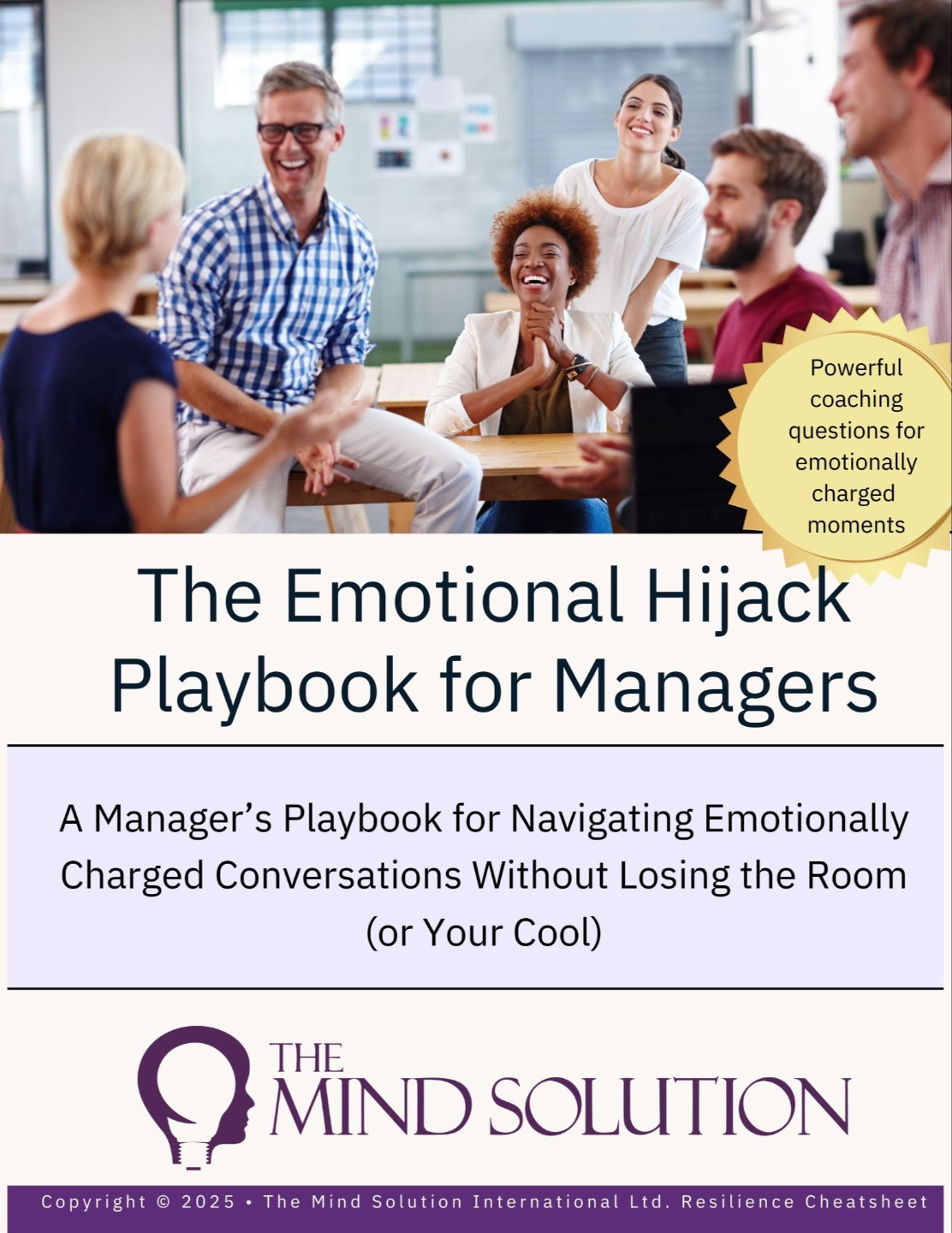Bridging the Gap Between High Performance and Wellbeing
Aug 18, 2025
The Secret to High Performance at Work
During my time as an HR leader, the concept of ‘high performance’ was a significant focal point in our HR strategies.
Back then, the term “high performance” often felt like a buzzword, and nowadays, it seems the spotlight has shifted to the notion of ‘agile working.’
During my time as the HR Manager at British Airways Holidays, it became clear that the organisation expected high performance from employees and even awarded a performance-related bonus. Yet the notion of what high performance looked like lacked clarity for a lot of people.
I plugged this gap by creating a comprehensive competency framework that helped employees recognise what high performance looked like at different levels, communicating our expectations so employees were clear about the standard of performance.
Performance was broken into specific job-related areas such as Commercial Acumen, Relationship Management, Project Management, Negotiating and Influencing, Technical Expertise and Specialist Knowledge and so on.
This approach worked well, and people had a clear framework, understanding what the different levels of performance looked like:
-
Consistently exceeds the standard
-
Meets & improves the standard
-
Achieves the standard
-
Improvement required
-
Unacceptable level of performance
Looking back, with what I now understand about performance and the link with wellbeing and mental health, I can see that what was missing to help employees truly excel in their role was wellbeing and resilience training.
What is resilience at work?
The terms wellbeing at work and resilience have evolved significantly over the past decade. Resilience at work was once seen as bouncing back or “pushing through” tough situations.
Now resilience is seen as the capacity to adapt, recover, and grow in the face of stress, adversity, or change, without becoming overwhelmed or permanently diminished by the experience.
It’s not just “bouncing back” to how things were before; true resilience often means emerging with greater perspective, strength, or skills because of what you’ve navigated. It draws on emotional regulation, problem-solving, and a sense of meaning or purpose to keep moving forward even when circumstances are challenging.
In my view, and something we teach in our employee wellbeing webinars, is that as individuals, we already are resilient. This surprises people! Employees and business leaders often believe that resilience is something they have to learn or grow, or develop.
Instead, we point people to what is compromising their natural innate resilience, which is their conditioned responses.
How to build resilience at work
Drawing from my experience as a Psychotherapist who has worked with hundreds of individuals, building resilience at work starts with an understanding of how the mind and body work, and how we develop conditioned responses, which include:
-
Habitual thought patterns
-
Emotional responses
-
A lack of self-awareness and consciousness
-
Behaviours
All too often, organisations try to increase high performance by focusing specifically on behaviour, and the types of behaviour that drive high performance. To understand why behaviour is not the starting point for high performance, let’s delve into how the mind operates.
Our mind comprises two primary aspects: the conscious mind and the unconscious mind.
The conscious mind, often referred to as the thinking mind or the prefrontal cortex, constitutes less than 5% of the overall mind’s functioning. This means that the unconscious mind is responsible for approximately 95% of our emotional responses, behaviours, thought patterns, and even the body’s physiology. Think of the unconscious mind as a repository of programs, similar to a computer’s motherboard, governing various functions.
However, the unconscious mind can only execute what it has been programmed to do. Unless we are in a state of continuous, unwavering awareness and consciousness, the unconscious mind takes the lead.
Developing resilience at work
When we seek to initiate behavioural changes, we must concentrate on two critical components:
1. Nervous System Regulation
First and foremost, the ability to regulate your emotions and nervous system is paramount.
Your nervous system is the body’s communication network, made up of the central nervous system (brain and spinal cord) and the autonomic nervous system, which has two key branches: the sympathetic system (“fight or flight”) and the parasympathetic system (“rest and digest”).
When your nervous system is regulated, these two work in balance. You can handle challenges without tipping into overwhelm, adapt under pressure without burnout, and remain mentally sharp. Signs include:
-
Steady heart rate, even under pressure
-
Calm breathing patterns
-
Clear, solution-focused thinking
-
Emotional steadiness rather than reactivity
Mastering emotional and nervous system regulation is directly tied to high performance. In a regulated state, you make better decisions, communicate clearly, and maintain consistent focus. Without it, emotional hijacks, such as “amygdala hijacking”, derail performance, damage relationships, and increase errors.
High performers understand that regulation is non-negotiable. It allows them to stay composed in high-pressure situations, make well-considered decisions, and maintain strong working relationships.
2. The Power of Thought
What truly gives rise to our emotional responses and feelings is the power of thought. On any given day, we entertain an estimated 60,000–70,000 thoughts. Many pass without impact, but the ones we latch onto create a chain reaction.
Because we operate from conditioning more than 95% of the time, without self-awareness, we’re limited by our current level of consciousness. Thought quality drives performance quality.
The Thinking–Feeling Loop
Here’s how it works:
-
Thought shapes feeling: “I’m behind” → stress rises.
-
Feeling shapes thought: Stress generates more anxious thoughts.
-
The loop intensifies, clouding judgment and narrowing focus.
When emotional arousal is high, we begin to “think our feeling” — making decisions based on emotion, not facts. Self-awareness and regulation break this loop, restoring clarity and high-performance capacity.
Example of resilience at work
Consider this scenario: a team member makes a mistake. If your thoughts spiral into “They always do this… I’m never respected… I don’t know why I bother,” you’re on a runaway train of thought leading to frustration and anger.
If you can recognise the trap and regulate your emotions, you can hit the brakes before performance suffers. If not, judgment becomes clouded, focus drops, and relationships strain.
Mental Health at Work Commitment
-
McKinsey (2025): Companies embedding emotional intelligence and wellbeing practices see 31% higher productivity and 23% lower absenteeism.
-
CIPD Europe (2024): 78% of employees say nervous system skills training improves both resilience and productivity.
-
WHO Europe (2024): Work-related stress affects 24% of employees, costing €45bn annually in lost productivity and healthcare.
Wellbeing at work
Achieving and maintaining high performance isn’t an external endeavour; it starts within. When employees understand how the mind works, they can identify their conditioned responses. The more employees raise their level of self-awareness, and in turn their level of consciousness, high performance is a natural byproduct, along with wellness at work.
Ready to bridge the gap between high performance and wellbeing?
Book our high-impact High Performance Wellbeing Webinar and give your team the tools to regulate their nervous system, sharpen their thinking, and perform at their best — consistently.
FAQs
-
How does nervous system regulation impact high performance?
It stabilises stress, keeps focus sharp, and supports clear, strategic decision-making. -
Why is thought awareness critical for leaders?
Because most thinking is conditioned, awareness allows leaders to choose better responses and elevate performance. -
What is the thinking–feeling loop?
It’s the feedback cycle where thoughts trigger feelings and feelings fuel thoughts; awareness breaks it. -
Can resilience really be taught?
We already have resilience; training removes what blocks it, such as conditioned responses. -
How do wellbeing webinars boost performance?
They equip teams with tools for self-regulation, emotional agility, and sustained focus under pressure.
The Emotional Hijack Playbook For Managers
A Manager’s Free Resource for Navigating Emotionally Charged Conversations Without Losing the Room (or Your Cool).
Perfect to use in your next one-to-one.







